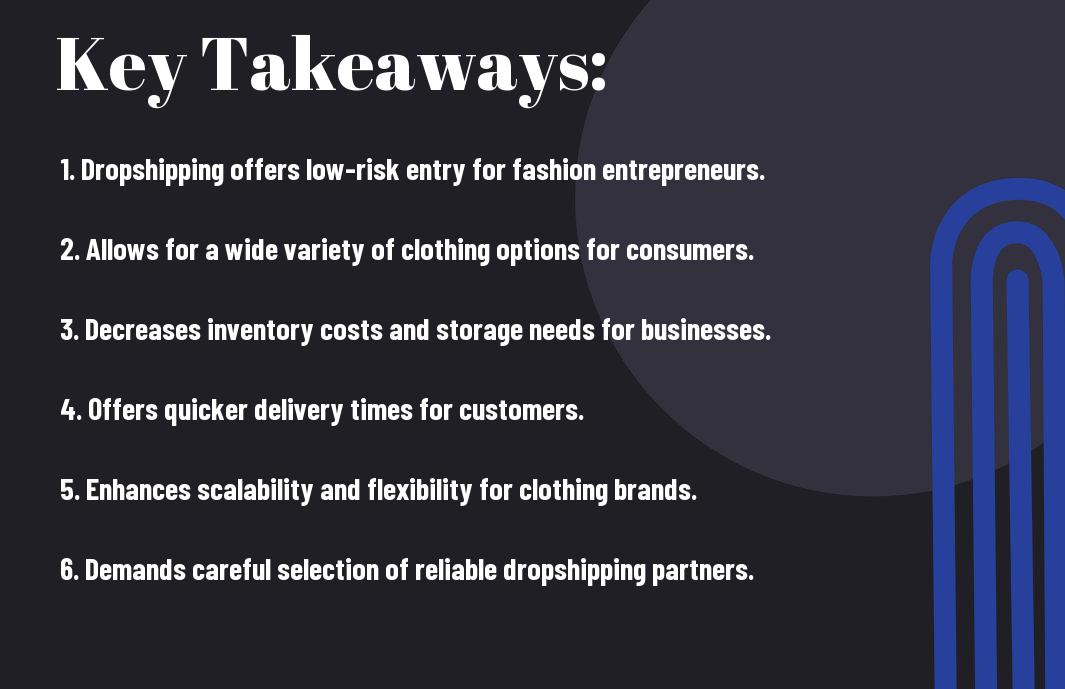Can Drop Shipping Revolutionize The Clothing Industry? Find Out How!
Drop shipping has been making waves across various industries, but its impact on the clothing industry is especially significant. This innovative business model allows retailers to sell products without holding any inventory, minimizing upfront costs and risks. In an industry where trends change rapidly and excess inventory can lead to substantial losses, drop shipping offers a solution to streamline operations and adapt to consumer demands swiftly. However, it is crucial for businesses to carefully select reliable suppliers to maintain quality control and ensure customer satisfaction. Can drop shipping truly revolutionize the clothing industry? Let’s explore into the details to find out how this business model is reshaping the way we shop for clothes.
Key Takeaways:
- Reduced inventory costs: Drop shipping allows clothing retailers to operate without holding inventory, thus reducing storage costs and the risk of unsold items.
- Broader product range: Drop shipping enables retailers to offer a wider variety of clothing items to customers without the need for physical store space.
- Enhanced flexibility: Clothing retailers can easily add or remove products from their online store without the constraints of physical inventory.
- Lower upfront investment: With drop shipping, retailers do not need to invest heavily in inventory, making it a cost-effective option for starting a clothing business.
- Focus on marketing and customer experience: By outsourcing fulfillment to drop shipping suppliers, clothing retailers can concentrate on marketing strategies and providing an exceptional customer experience.

The State of the Clothing Industry
One 5 Steps to Start Clothing Dropshipping can offer valuable insights into the current state of the clothing industry. Understanding the landscape is crucial for those looking to make a mark in this competitive market.
Traditional Retail vs. E-commerce Trends
Trends in the clothing industry are constantly evolving, with traditional retail facing stiff competition from e-commerce platforms. As more consumers turn to online shopping for convenience and a wider range of options, brick-and-mortar stores are having to adapt to stay relevant. E-commerce trends show a steady rise in popularity, with drop shipping being a key strategy for retailers to streamline their operations and expand their reach.
With e-commerce offering convenience and accessibility, traditional retail is facing challenges in keeping up with changing consumer preferences. The shift towards online shopping is reshaping the industry, emphasizing the importance of adaptability and innovation in today’s competitive market.
The Demand for Fast Fashion and Sustainability
Clothing consumers today are increasingly looking for a balance between fast fashion and sustainability. The demand for trendy clothing at affordable prices drives the popularity of fast fashion, but there is also a growing awareness of the environmental and social impact of this industry. As a result, sustainable fashion practices are gaining traction, with consumers seeking ethically produced and environmentally conscious clothing options.
Fashion retailers are facing the challenge of meeting the demand for both fast fashion and sustainability, requiring a delicate balance between profit-driven strategies and ethical considerations. The future of the clothing industry lies in embracing sustainable practices while still delivering on consumer expectations for trendy and affordable clothing.
The Impact of Drop Shipping on Clothing Retailers
In recent years, drop shipping has been making waves in the clothing industry, offering a new way for retailers to streamline their operations, reduce costs, and enhance customer satisfaction. The impact of drop shipping on clothing retailers has been significant, with many businesses experiencing a transformation in their business models and strategies. Let’s investigate deeper into the specific ways in which drop shipping has influenced the clothing retail sector.
Cost Reduction and Inventory Management
With the traditional retail model, clothing retailers often face challenges related to high upfront costs for inventory storage and management. Drop shipping eliminates the need for retailers to hold inventory, as products are shipped directly from the supplier to the customer. This reduces the costs associated with warehousing, inventory management, and unsold stock.
Furthermore, drop shipping allows retailers to offer a wider range of products without the risk of overstocking or obsolescence. By partnering with multiple suppliers, retailers can expand their product offerings and adjust their inventory according to demand, optimizing their product mix and minimizing the risk of dead stock.
Customization and Brand Differentiation
Inventory management is crucial for clothing retailers to stay competitive in the market. With drop shipping, retailers can leverage the flexibility to customize their product offerings and differentiate their brand from competitors. By working closely with suppliers and manufacturers, retailers can create unique products, exclusive collaborations, and limited-edition releases to attract customers and build brand loyalty.
Clothing retailers can also utilize drop shipping to experiment with new designs, materials, and styles without committing to large production runs. This empowers retailers to stay on top of the latest trends and cater to diverse customer preferences, ultimately enhancing their brand image and market positioning.

The Consumer Perspective
Shopping Experience and Expectations
Experience shopping for clothing plays a significant role in shaping consumer expectations. Despite the convenience and wide variety of choices that drop shipping offers, some consumers may still be wary of the quality and accuracy of the products they receive. The lack of physical interaction with the product before purchase can lead to dissatisfaction if the item does not meet expectations.
However, the convenience of browsing through a diverse range of clothing options from the comfort of one’s home is a major draw for many consumers. The seamless online shopping experience that drop shipping provides, with easy payment and shipping processes, can enhance the overall satisfaction with the purchase.
Quality, Shipping Times, and Return Policies
Times may vary when it comes to shipping with drop shipping, which can be a concern for consumers who expect quick delivery. Long shipping times can lead to frustration and may deter some customers from making repeat purchases. Additionally, return policies can be a critical factor in consumer decision-making, as the ease of returns can influence the likelihood of making a purchase.
Quality control is paramount in the clothing industry, and consumers expect accurate representations of products online. When drop shipping is involved, there can be a risk of inconsistencies in quality across different suppliers. It is essential for drop shipping companies to maintain high standards and ensure that products meet consumer expectations to build trust and loyalty.
The Future of Drop Shipping in Clothing
Technological Advancements and Integration
Now, in the era of technological advancements, the future of drop shipping in the clothing industry looks promising. Integration of cutting-edge technologies such as artificial intelligence, big data analytics, and machine learning has revolutionized the way clothing retailers manage their inventory, streamline operations, and deliver a seamless shopping experience to customers.
For clothing businesses, leveraging these technologies can enhance supply chain management, optimize forecasting accuracy, and personalize customer recommendations. Automated inventory management systems can help prevent stockouts and overstock situations, improving overall efficiency and profitability in the drop shipping model.
Challenges and Opportunities for Growth
With the rapid growth of e-commerce and the increasing demand for fast and convenient shopping experiences, clothing retailers face both challenges and opportunities in the drop shipping model. Adapting to changing consumer preferences, managing complex logistics networks, and ensuring timely delivery of products present challenges that require innovative solutions.
With the right strategies in place, clothing businesses can turn these challenges into opportunities for growth. Expanding into new markets, diversifying product offerings, and establishing strong partnerships with reliable suppliers are key avenues for sustained growth and success in the competitive landscape of drop shipping.
Shipping plays a pivotal role in the drop shipping model, affecting customer satisfaction and brand reputation. Efficient shipping processes, reliable tracking mechanisms, and proactive communication with customers are essential components for a successful drop shipping strategy in the clothing industry.
Final Words
With these considerations in mind, it is clear that drop shipping has the potential to revolutionize the clothing industry. By eliminating the need for traditional inventory management and reducing upfront costs, drop shipping offers a cost-effective and efficient way for clothing retailers to expand their businesses. With the rise of online shopping and changing consumer preferences, adopting drop shipping models can help clothing companies stay competitive in the market and reach a wider audience. Overall, embracing drop shipping can lead to increased profits, streamlined operations, and a more sustainable approach to selling clothing in today’s dynamic marketplace.
FAQ
Q: What is drop shipping in the clothing industry?
A: Drop shipping is a supply chain management method where the retailer does not keep goods in stock but instead transfers customer orders and shipment details to a manufacturer or wholesaler, who then ships the goods directly to the customer.
Q: How can drop shipping revolutionize the clothing industry?
A: Drop shipping can revolutionize the clothing industry by eliminating the need for retailers to hold inventory, reducing overhead costs, minimizing risks, and allowing for a wider selection of products without the need for large storage spaces.
Q: What are the benefits of drop shipping for clothing retailers?
A: Some benefits of drop shipping for clothing retailers include lower upfront investment, reduced financial risk, access to a wider range of products, simplified order fulfillment processes, and the flexibility to scale the business quickly.
Q: How can drop shipping improve customer experience in the clothing industry?
A: Drop shipping can improve customer experience by offering a larger variety of products, faster shipping times, reduced out-of-stock items, and seamless order processing, leading to higher customer satisfaction and retention rates.
Q: What challenges may clothing retailers face when implementing drop shipping?
A: Some challenges clothing retailers may face with drop shipping include issues with product quality control, longer shipping times, potential supplier reliability issues, managing multiple supplier relationships, and maintaining brand consistency across different product lines.
Q: How can clothing retailers overcome the challenges of drop shipping?
A: Clothing retailers can overcome drop shipping challenges by carefully vetting suppliers, establishing clear communication channels, utilizing quality control measures, implementing efficient inventory management systems, and continuously monitoring and optimizing their supply chain processes.
Q: What trends do we see in the future of drop shipping in the clothing industry?
A: In the future, we may see increased automation in order processing and fulfillment, more sustainable and ethical sourcing practices, personalized product offerings through data analytics, and collaborative partnerships between retailers and suppliers to create unique and exclusive clothing lines.







